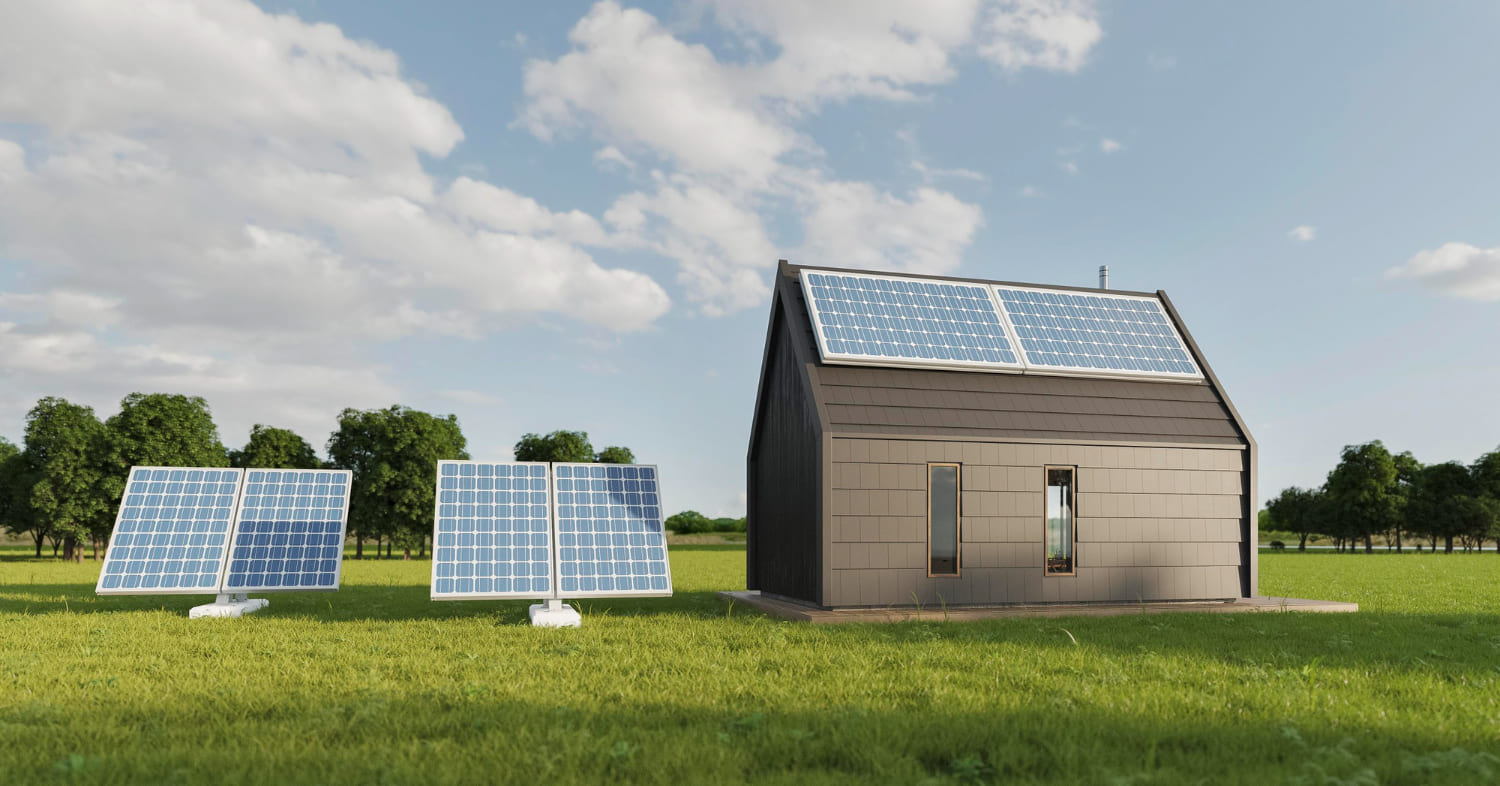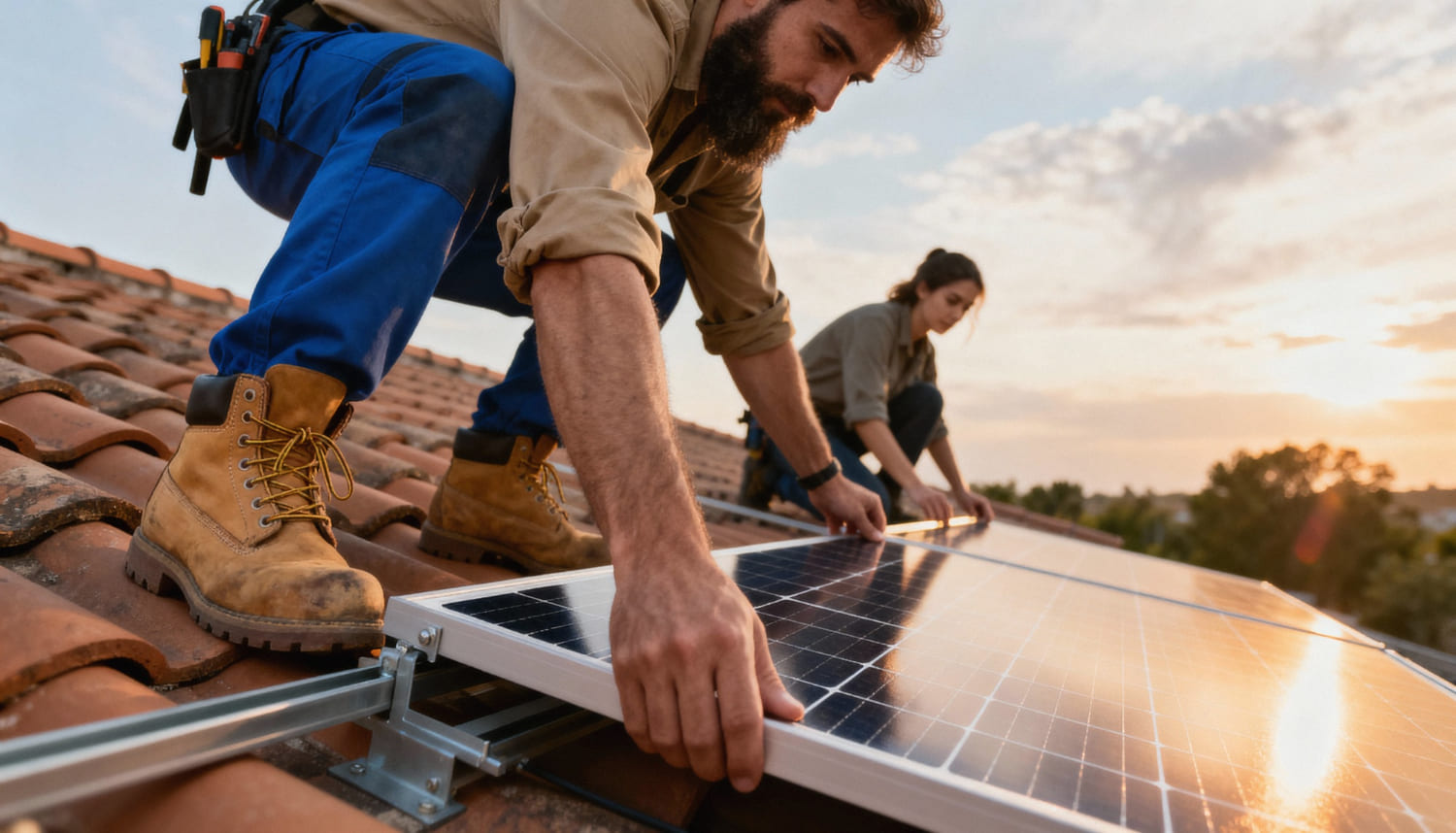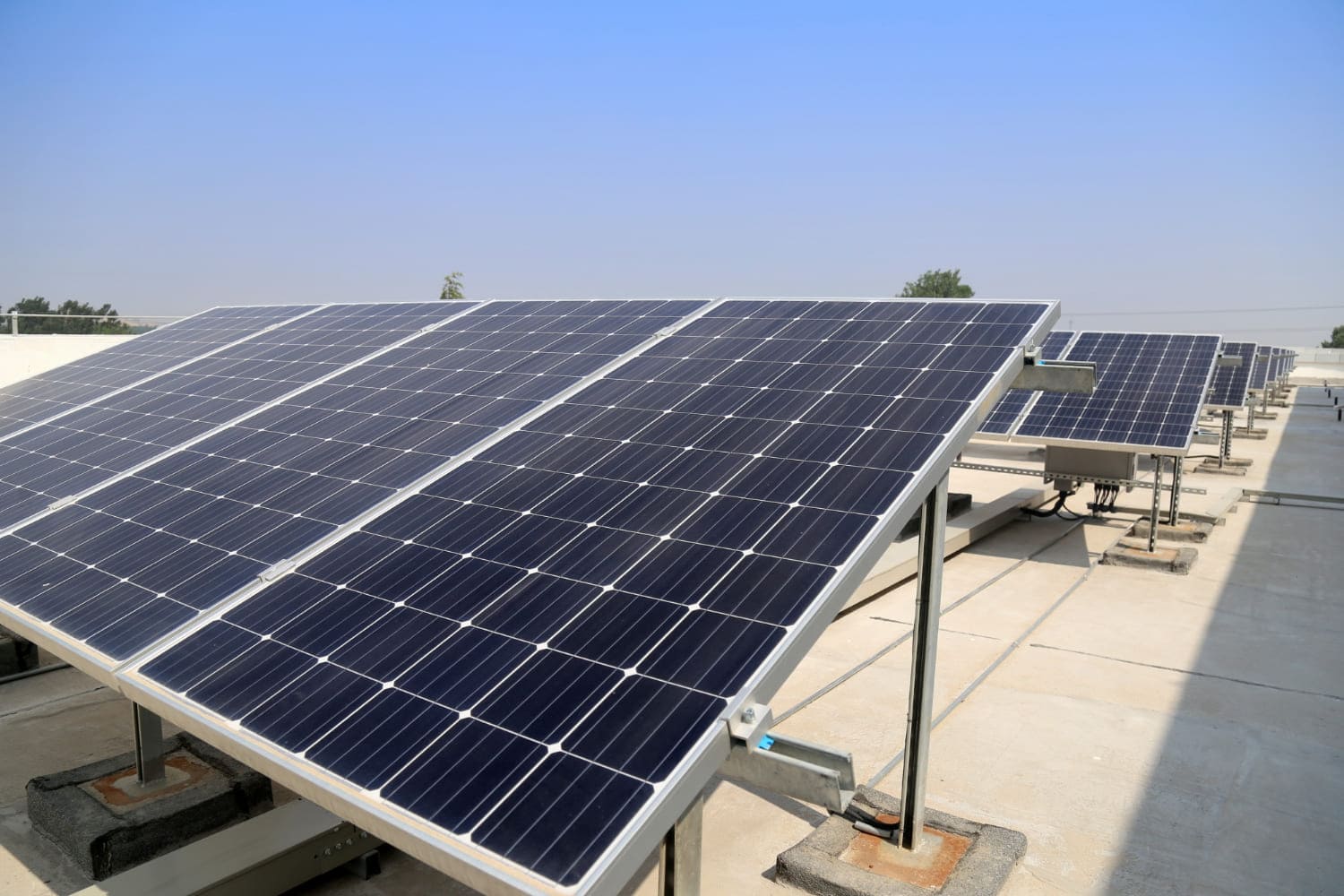

Solar panel mounts and racking systems are the foundational hardware that secures solar panels to rooftops or ground surfaces, typically accounting for approximately 10% of total installation costs, around $1,000 for a $10,000 system or $1,800 for an $18,000 average 6 kW installation.
Modern solar mounting systems consist of three essential components: roof attachments (fasteners with protective flashing), mounting rails (horizontal supports), and module clamps (connectors securing panels). These weather-resistant components, manufactured primarily from aluminum and stainless steel, are engineered to last 25-30 years while withstanding extreme weather conditions.
Homeowners have two primary mounting options: rooftop installations using specialized brackets designed for asphalt shingles, metal roofs, tile, and other materials, or ground-mount systems ideal for properties with limited roof space, unfavorable roof orientation, or shading issues. Leading manufacturers, including IronRidge and Unirac, offer solutions for both applications, with professional installers providing expertise in selecting optimal configurations based on roof type, geographic location, and energy production goals.
Understanding mounting systems is crucial because proper installation prevents roof damage, maximizes energy capture through optimal panel tilt angles, and ensures long-term structural integrity, making the difference between a solar investment that performs reliably for decades versus one that underperforms or requires costly repairs.
Recent years have witnessed explosive growth in the renewable energy sector, driving remarkable advancements in residential rooftop mounting technology. Today's market offers solar panel mounting solutions engineered for every roof type imaginable, whether you're working with asphalt shingles, clay tiles, standing seam metal, or alternative roofing materials.
Contemporary solar mounting assemblies incorporate roof attachments (featuring optional flashing), mounting rails, and module clamps. These components enable installers to execute swift, efficient installations that secure solar panels for decades while preserving roofing integrity and preventing water infiltration. Ground-mounting racks present another viable alternative for residential solar design projects.
Your roof configuration or ground installation requirements won't limit your choices; numerous solutions exist for every scenario. Professional solar installers possess the expertise to recommend optimal configurations that maximize your system's performance.
Explore our comprehensive analysis of solar panel mounting solutions below, featuring evaluations of three leading mount manufacturers and a detailed comparison of rooftop versus ground-mounted installations.
Solar panel mounts and racking systems serve as the foundational equipment securing your solar panels in position.
These mounting systems enable panel adjustment to achieve optimal tilt angles, calculated based on geographical latitude, seasonal variations, or daily sun positioning, maximizing solar energy capture. Installation typically occurs either on rooftops using specialized roof mounts or on ground surfaces with dedicated configurations.
Financially, mounting and racking equipment represents approximately 10% of your complete solar system investment. Consider this example: for a $10,000 solar installation, expect racking components to account for roughly $1,000.
Your final cost depends on several variables: racking type selection, required equipment quantity, and professional installation labor rates.
Solar panel mounting brackets represent the industry-standard installation method. These brackets constitute heavy-duty hardware manufactured from stainless steel or aluminum materials. Whether designed for rooftop or ground applications, all solar racking and mounting products must satisfy rigorous standards, ensuring durability and structural resilience against extreme winds and severe weather conditions.
Let's examine the essential components comprising racking equipment, giving you clearer insight into the infrastructure supporting your solar panels.
Solar panel racking infrastructure consists of three primary elements:
Each component fulfills a critical function in supporting your panels and optimizing solar power generation.

Roof attachments function as fasteners secured directly into your roofing structure, anchoring the entire racking system.
Flashing, plastic, or metal protective shields inserted between shingles surround the drilled openings, creating watertight seals preventing moisture penetration. Attachment specifications vary according to roof type and must comply with solar permit application requirements.
Module clamps bridge the connection between installed roof attachments and mounting rails. Various clamp designs accommodate different angles and corner positions of solar panels.
Following roof penetration, roof attachments connect to mounting rails through module clamps, ultimately bearing the solar panel weight. Proper wire management and conduit practices ensure clean integration with the mounting system.
Railless racking alternatives exist; however, rail-based systems dominate the market due to their compatibility with diverse roof angles and widespread installer familiarity with rail mounting techniques.
While numerous manufacturers produce solar panel mounts, the market features several established companies recognized for quality products. Among the options available, brands like IronRidge, Quick Mount, and Unirac have developed reputations within the industry, though each presents unique characteristics worth examining for your specific needs.
Two frequently recommended solar mounting and racking manufacturers include
Initially focused on small-scale, off-grid applications, IronRidge has expanded its portfolio to include the XR rail series designed for pitched roofs. The company also offers product lines for flat roofs and ground mount applications. As with any manufacturer, verify current specifications and compatibility with your installation requirements.
Unirac produces mounts designed for flat roofs and fixed-tilt ground-mount frameworks. Their mounting systems feature adjustable tilt options, which can enable solar array orientation independent of roof angle. Product performance depends on proper installation and site-specific conditions.
Multiple manufacturers offer reliable mounting and racking solutions addressing various solar installation requirements. Product availability, features, and pricing may vary by region and can change over time, so verify current information before making purchasing decisions.
You can research options through local solar equipment distributors for DIY installations. However, professional solar installation services typically procure mounting equipment on your behalf, leveraging their expertise to select components matched to your roof characteristics and solar panel specifications based on current industry standards.
DIY solar panel projects introduce additional complexity. Fully assembled solar panel mount systems rarely sell as complete units. Instead, purchase individual components separately to assemble a complete mounting solution. For DIY enthusiasts, complete solar panel kits, including integrated racking solutions, simplify the process while ensuring compliance with permitting requirements.
When purchasing individual components, you can explore racking equipment through various online suppliers and retailers to acquire the separate components forming your racking system. Always verify proper sizing compatibility with your chosen solar panels and ensure products meet current safety certifications.
The most reliable approach to ensuring seamless solar installation, utilizing equipment specifically suited to your roof, involves partnering with licensed solar installation professionals who stay current with building codes and project approval processes and manufacturer specifications.

Rooftop solar installations face inherent limitations imposed by roof characteristics. Homeowners choosing ground-mounted solar panels typically do so for three primary reasons:
Solar panels generate maximum energy when oriented southward. Your home's orientation may preclude this possibility. Rooftop installations may encounter additional obstacles, including shade from neighboring structures and vegetation.
Available options include ground mounts secured into earth or ballasted mounts. Ballasted systems rest atop ground surfaces without securing mechanisms, held in position by panel weight alone. Ballasted ground mounts enjoy greater popularity due to installation without drilling requirements.
Ground mount options from various manufacturers, including established brands like IronRidge and Unirac, offer different features and specifications worth comparing. Ground-mounted systems are increasingly popular for optimizing solar energy production.
These systems are designed for outdoor durability and weather resistance, with the company offering warranty coverage. Specific warranty terms, features, and pricing should be verified directly with suppliers or installers, as specifications and availability may change.
Precise pricing remains challenging to specify, depending on solar array dimensions, material costs at purchase time, and supplier practices requiring quote requests.
The Unirac Ground Fixed Tilt system combines construction features aimed at durability with warranty protection. The company emphasizes shipping efficiency and assembly processes. As with any product, actual performance depends on proper installation and site conditions.
Collaborate with licensed solar installers to identify which ground mount system best suits your terrain and solar panel specifications, as they can provide current information on available products and compatibility.
Including racking and mounting infrastructure, an average 6 kW solar system costs approximately $18,000, based on the US average solar panel price of around $3.00 per watt as of January 2023. After claiming the 30% federal solar tax credit, your net cost becomes $12,600.
Note: Pricing information reflects market conditions at the time of writing and may fluctuate based on material costs, labor rates, and regional variations. Tax incentive availability and percentages are subject to change based on current legislation. Always verify current pricing and incentive programs with qualified installers and tax professionals.
Your energy requirements ultimately determine whether solar tracking systems warrant installation, though standard roof- or ground-mounted solar panels suit most residential applications. Understanding solar interconnection options is also important when planning your system.
Partnering with licensed installers provides the optimal path to determining which solar panel mount system matches your roof specifications. Research available mount manufacturers and discuss preferences with your solar installer, who can provide objective recommendations based on your specific situation.
For comprehensive guidance on navigating the entire installation process, explore resources covering everything from commercial solar design to compliance.
Essential Points
Disclaimer: Brand mentions in this content are for informational purposes only and do not constitute endorsements. Product specifications, features, pricing, and availability may change without notice. Always conduct independent research and consult with licensed solar professionals before making installation decisions. Warranty terms and coverage should be verified directly with manufacturers or authorized dealers.
Selecting the right solar panel mounting and racking system represents a critical decision in your solar energy journey. While these components may account for only 10% of your total installation cost, they provide the foundational support that ensures your solar panels perform optimally for decades to come.
Whether you're considering rooftop installation or exploring ground-mount alternatives, understanding the essential components, roof attachments, module clamps, and mounting rails empowers you to make informed decisions about your solar investment. The technology has evolved significantly to accommodate every roof type and terrain condition, eliminating previous barriers that once limited solar adoption worldwide.
Working with licensed solar installers remains the most effective approach to navigate the various mounting options available in today's market. These professionals bring expertise in assessing your specific property characteristics, local building codes, and weather conditions to recommend systems that maximize energy production while maintaining structural integrity. Modern installations also require compliance with rapid shutdown requirements for safety.
Remember that your solar panel mounting system isn't just about securing panels in place; it's about optimizing tilt angles, ensuring weatherproof installation, and creating a durable infrastructure that protects your long-term investment. Understanding technical aspects like three-line diagrams and supply-side connections can help you better communicate with your installer.
The transition to solar energy represents both an environmental commitment and a financial investment, supported by organizations like the American Solar Energy Society that promote renewable energy adoption. By understanding mounting and racking fundamentals, you're better positioned to participate actively in the planning process and ensure your solar system delivers maximum performance and reliability for years to come.
How long do solar panel mounting systems typically last?
Quality solar panel mounting and racking systems are engineered to last 25-30 years or more when properly installed. Most reputable manufacturers design their mounting hardware to match or exceed the lifespan of the solar panels themselves. The materials used, primarily aluminum and stainless steel, resist corrosion and withstand extreme weather conditions, including high winds, snow loads, and temperature fluctuations. Regular inspections every few years can help identify any potential issues early, though well-installed systems typically require minimal maintenance. The longevity of your mounting system depends on factors including material quality, installation expertise, local climate conditions, and adherence to manufacturer specifications during installation.
Will installing solar panel mounts damage my roof?
When installed correctly by licensed professionals, solar panel mounts should not cause roof damage or leaks. Professional installers use flashing, waterproof barriers installed around roof penetrations, to prevent water infiltration at attachment points. The drilling process creates small, controlled penetrations that are properly sealed and integrated with your existing roofing materials. In fact, solar panels can actually protect the roof sections they cover from weather exposure, potentially extending roof life in those areas. Reputable installers carry liability insurance and often provide workmanship warranties covering any installation-related issues. The key is working with experienced professionals who understand proper flashing techniques and roof-specific installation requirements for your particular roofing material.
Can I install solar panel mounts myself, or do I need a professional installer?
While DIY solar panel mounting is technically possible for individuals with construction experience, professional installation is strongly recommended for several important reasons. Licensed installers understand local building codes, permitting requirements, and structural load calculations necessary for safe installation. They have experience with proper flashing techniques that prevent roof leaks and know how to identify potential issues like inadequate roof structure or shading problems. Professional installation also typically includes warranties covering both equipment and workmanship, protecting your investment. Additionally, many utility companies and energy efficiency programs require professional installation to qualify for rebates or net metering agreements. If you're determined to pursue DIY installation, consider starting with ground-mount systems, which present fewer risks than rooftop projects, and ensure you thoroughly research all safety and permitting requirements.
What's the difference between ballasted and penetrating ground-mount systems?
Ballasted ground-mount systems rest on top of the ground surface and rely on weight from the mounting structure, panels, and sometimes added ballast materials to remain stable without drilling into the ground. These systems offer advantages including easier installation, no ground penetration, potential portability, and suitability for areas where drilling isn't permitted or practical. However, they typically require more land area and may need additional ballast weight in high-wind regions. Penetrating ground-mount systems, conversely, use posts or anchors driven or cemented into the ground, providing superior stability and wind resistance while using less surface area. They're ideal for areas with high winds or unstable soil conditions but require more intensive installation work and create permanent ground alterations. Your choice depends on factors including local wind conditions, soil composition, land availability, zoning regulations, and whether you need a permanent or potentially relocatable installation.
How do I know if my roof can support the weight of solar panels and mounting equipment?
Most residential roofs can support solar panel installations, as a typical solar array with mounting equipment adds approximately 2-4 pounds per square foot, well within the load capacity of properly constructed roofs. However, determining roof suitability requires professional assessment. Licensed solar installers or structural engineers evaluate several factors, including roof age and condition, existing structural support, roofing material type, roof pitch and orientation, and local snow load requirements. Older roofs or those with existing structural issues may require reinforcement before installation, or you might need to complete roof replacement first to avoid removing and reinstalling panels prematurely. Some jurisdictions require structural engineering stamps for solar permits, particularly for larger systems or older buildings. Organizations like the World Bank and IEEE Power & Energy Society provide resources on renewable energy standards. During your initial solar consultation, reputable installers conduct roof assessments and can identify any concerns before moving forward with installation plans, ensuring your roof provides safe, adequate support for your green power system.
We are dedicated to providing top-notch solar permit services to homeowners, business owners, DIY, and solar installers. Contact us today.